
Land Acknowledgement Statement
Loyola University Chicago’s Land Acknowledgement
The culmination of a multi-year process, Loyola’s Land Acknowledgement started when a group of faculty, students, and staff convened to discuss what our university can do to welcome and support Indigenous people—a population that remains underrepresented in higher education. The group consulted with local Indigenous leaders, historians, students of Indigenous ancestry, and others. Together, they crafted the Land Acknowledgement statement, along with a set of recommendations on how our university can act in solidarity with Native peoples and advance our social justice mission. The university ratified the Land Acknowledgement in 2020, and we continue our efforts to build a supportive and welcoming environment for Indigenous people at Loyola. In 2023, the university installed campus signs displaying the Land Acknowledgement. The signs feature illustrations by Indigenous artist Buffalo Gouge.
Land Acknowledgement Statement
THE LOYOLA UNIVERSITY CHICAGO COMMUNITY ACKNOWLEDGES its location on the ancestral homelands of the Council of the Three Fires (the Ojibwa, Ottawa, and Potawatomi tribes) and a place of trade with other tribes, including the Ho-Chunk, Miami, Menominee, Sauk, and Meskwaki. We recognize that descendants of these and other North American tribes continue to live and work on this land with us. We recognize the tragic legacy of colonization, genocide, and oppression that still impacts Native American lives today.
As a Jesuit, Catholic university, we affirm our commitment to issues of social responsibility and justice. We further recognize our responsibility to understand, teach, and respect the past and present realities of local Native Americans and their continued connection to this land.
Land acknowledgment is a longstanding protocol of Indigenous peoples, helping connect past with present and build respect among and between nations. By providing a reflection point for all of us across our Chicagoland campuses, the hope is that it contributes to community and helps to further our understanding and deepen our Jesuit mission to advance reconciliation and justice.
Campus Signage Artwork
INDIGENOUS ARTIST BUFFALO GOUGE designed campus signage displaying Loyola’s Land Acknowledgement. He based the pieces on 19th-century photographs of Indigenous people, digitizing the images and transforming them into colorful illustrations. Gouge added objects and clothing ornamentation appropriate for the Potawatomi and other local tribes and set the figures over a historical map of the region. The background wash of maroon and gold creates a connection to Loyola. The images are overlain on a map of the original Indigenous peoples' occupancy of the land that is now called the Chicago region.
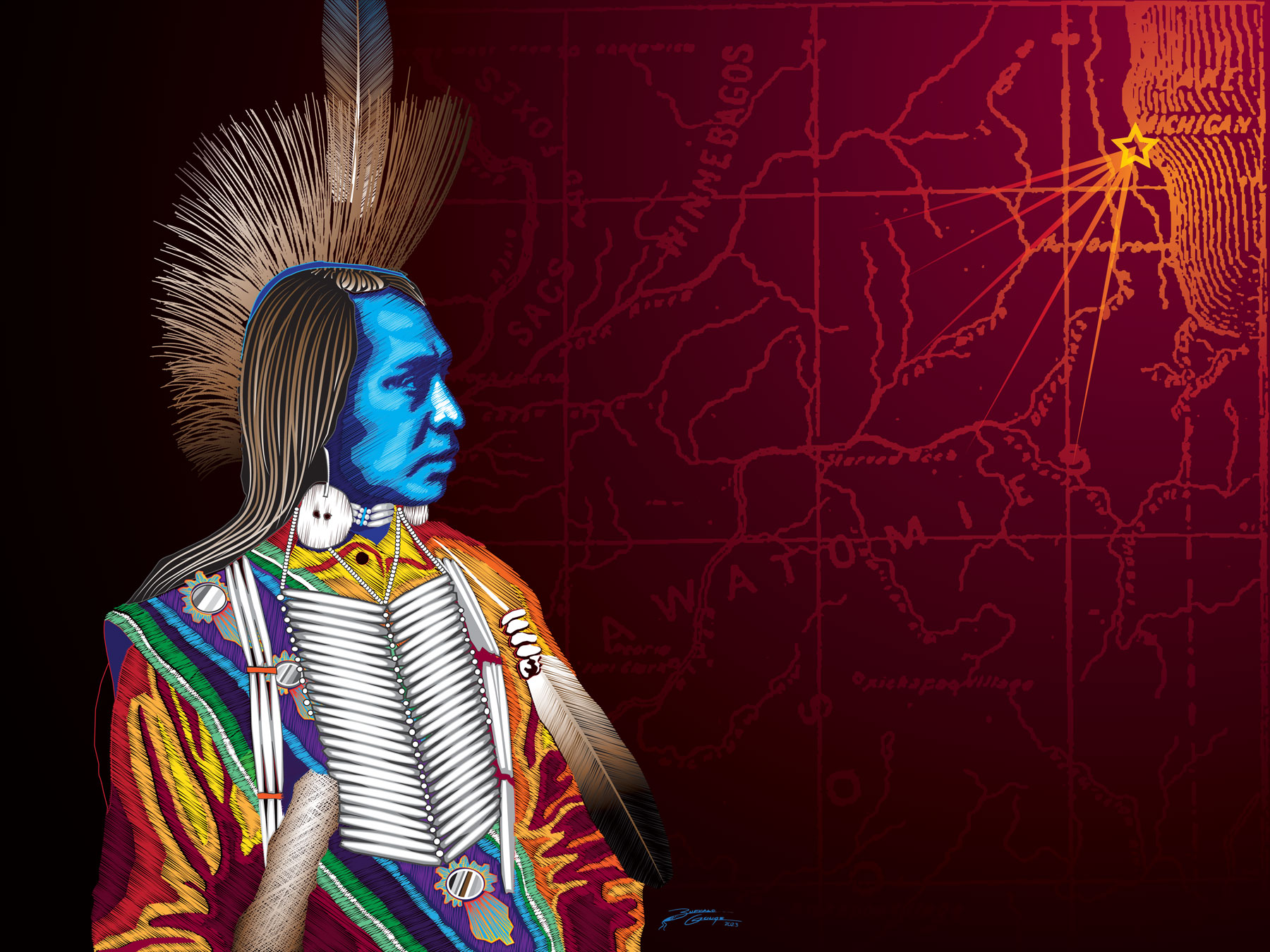
Water Tower Campus signage

Health Sciences Campus signage
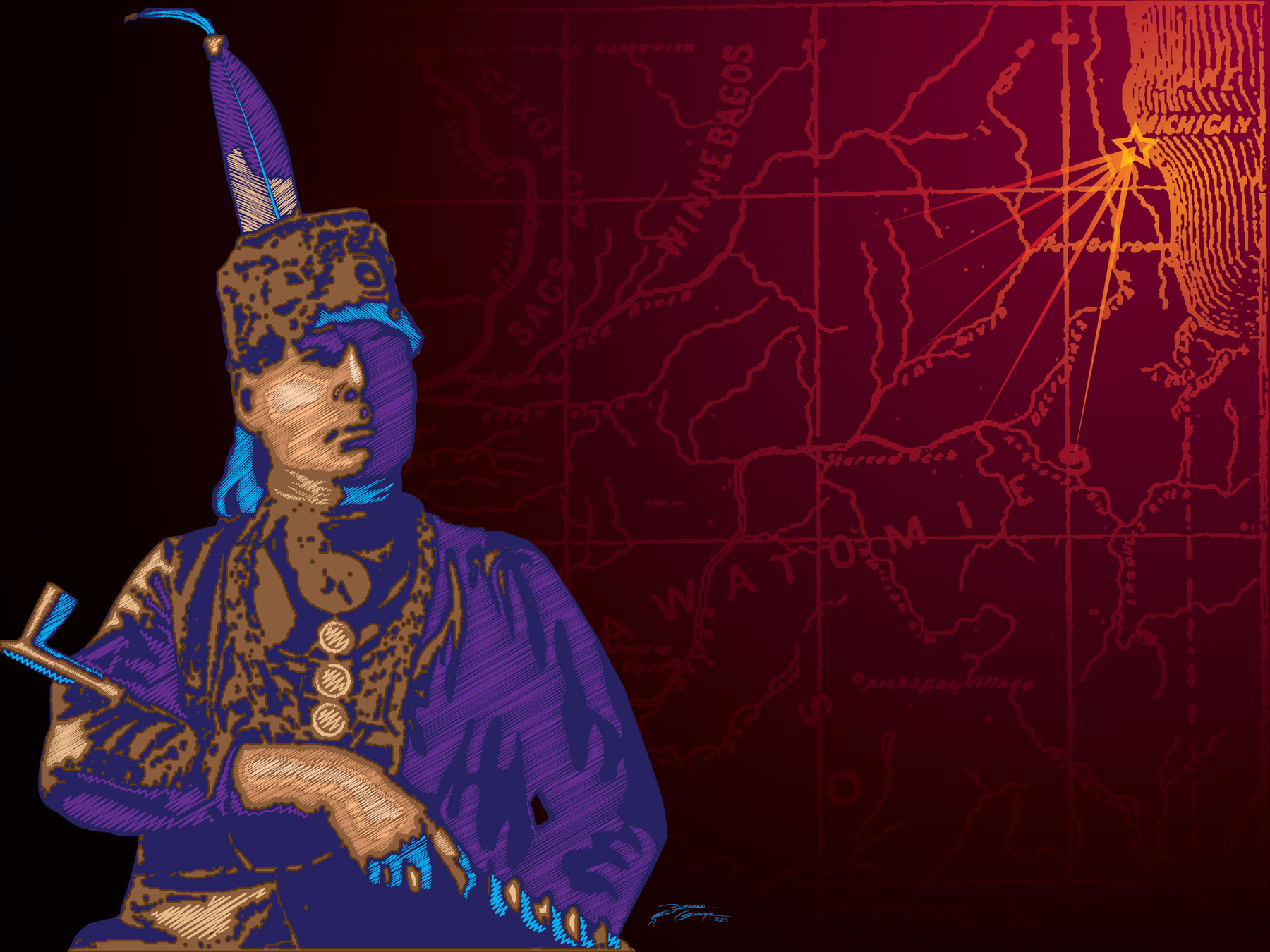
Loyola Retreat and Ecology Campus signage
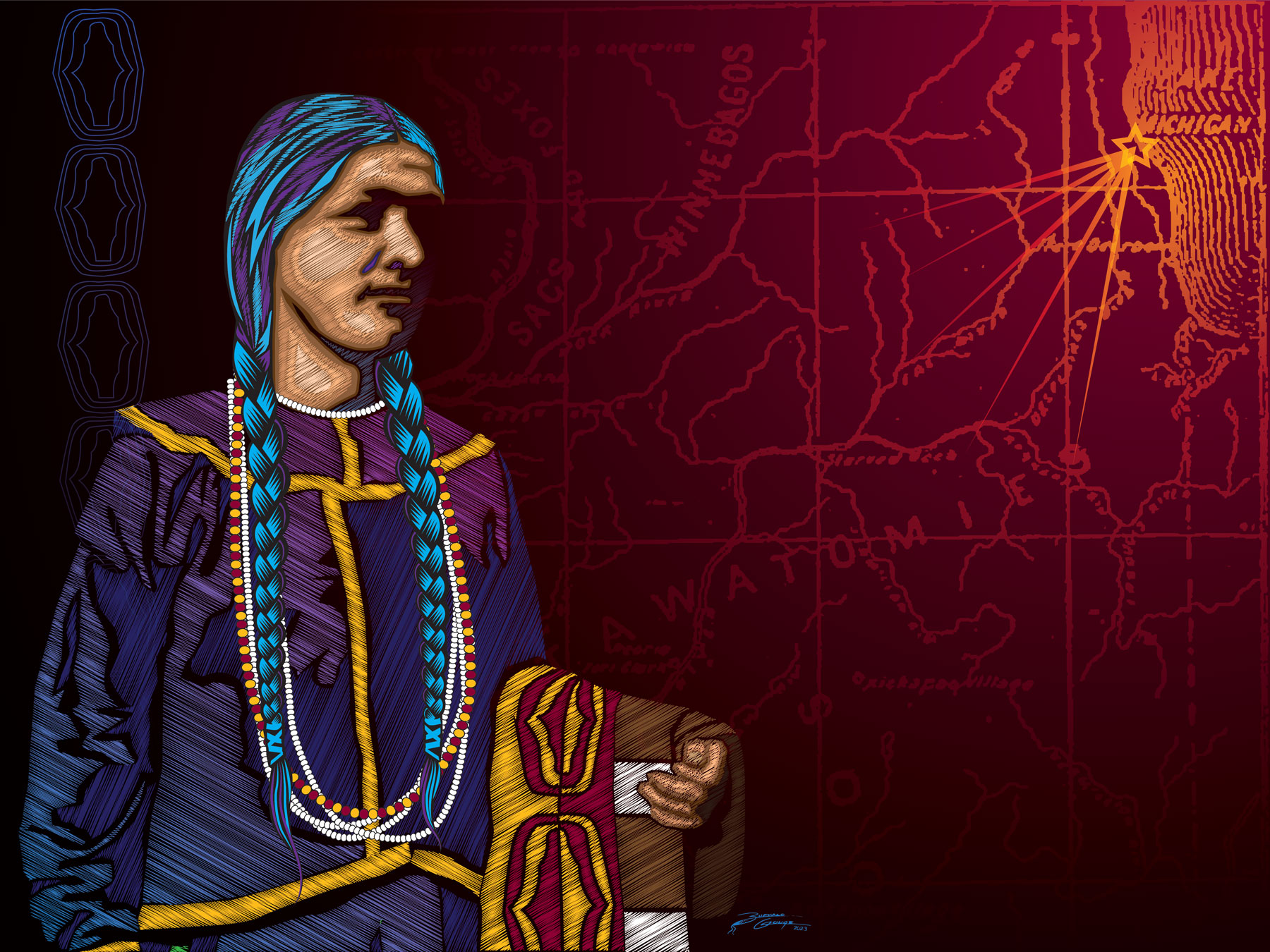
Lake Shore Campus signage, displayed on the west side of the East Quad
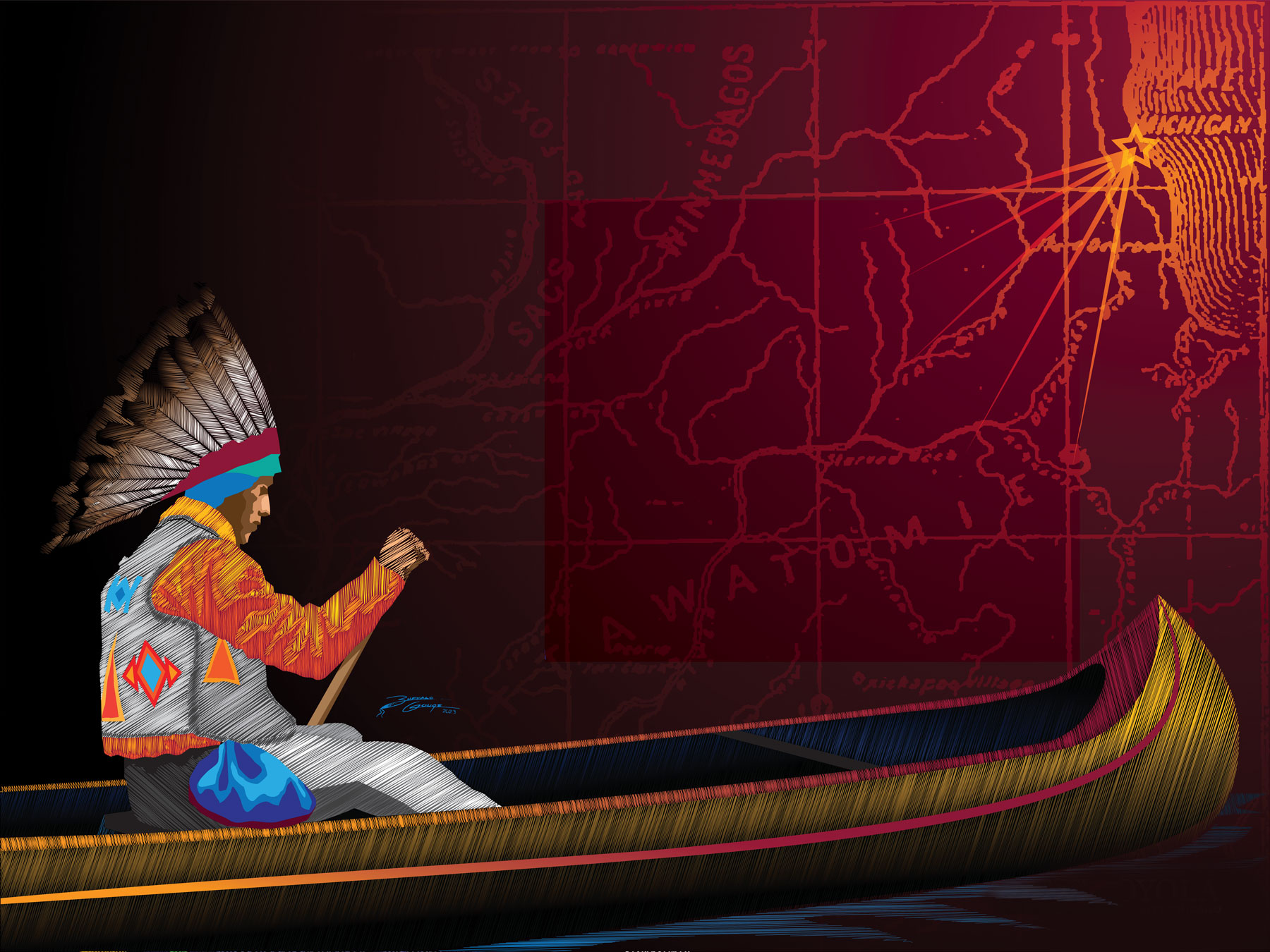
Lake Shore campus signage, displayed along the lakeshore path between the Crown Center and the Information Commons
Artist
Buffalo Gouge
BUFFALO GOUGE WAS BORN IN OKLAHOMA CITY, OKLAHOMA and is of Creek and Cherokee descent. He currently resides in Tahlequah, Oklahoma. Buffalo is a contemporary Native American artist, and his style is best described as fast with bright colors. He enjoys painting all types of subjects, but portraits are his main focus.
Buffalo attended the Institute of American Indian Arts (I.A.I.A.) in Santa Fe, New Mexico. After receiving his associate’s degree in fine arts, he stayed in Santa Fe to pursue his childhood dream of becoming a full-time professional artist. He achieved this dream in 2004.
Creek/Seminole artist Jerome Tiger remains Buffalo’s biggest inspiration. The beauty and graceful style of Tiger’s paintings first captured Buffalo’s attention. Buffalo says, “My eighth-grade art teacher showed me a few Oklahoma Native American artists like Robert Redbird, Rance Hood, and Gary White Deer. When she showed me Jerome Tiger, I was blown away. I couldn’t believe how strong and graceful his paintings were. I studied and studied his paintings for the next few years.”
When asked about his current inspiration behind his art, Buffalo said, “My son is the reason I began to paint again. When I brought out my paints and brushes and started to paint, Elijah was right there watching me closely.”
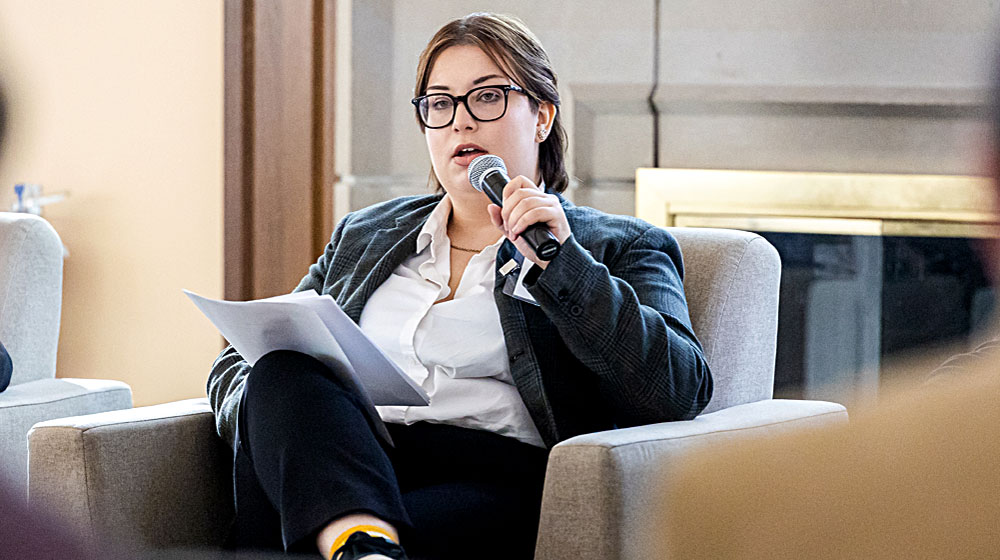
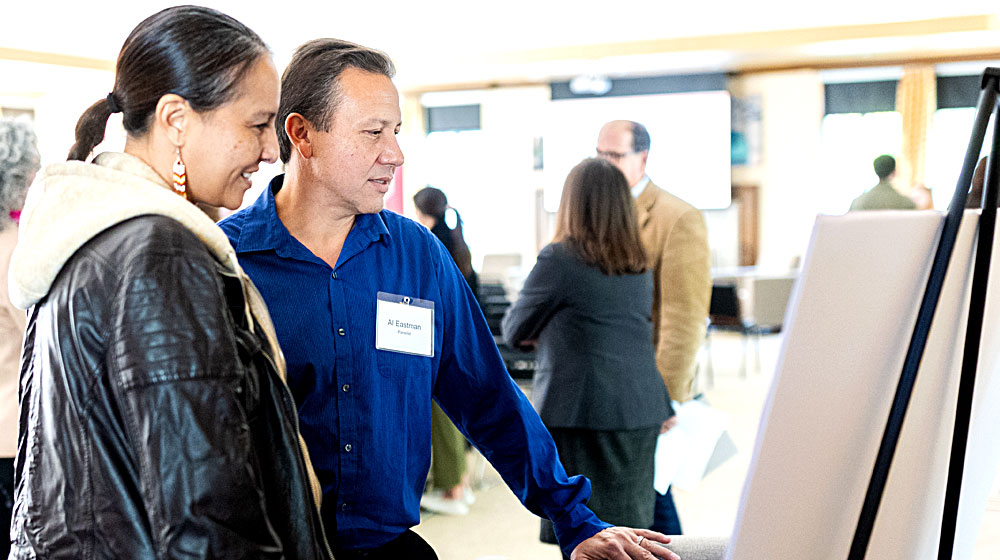
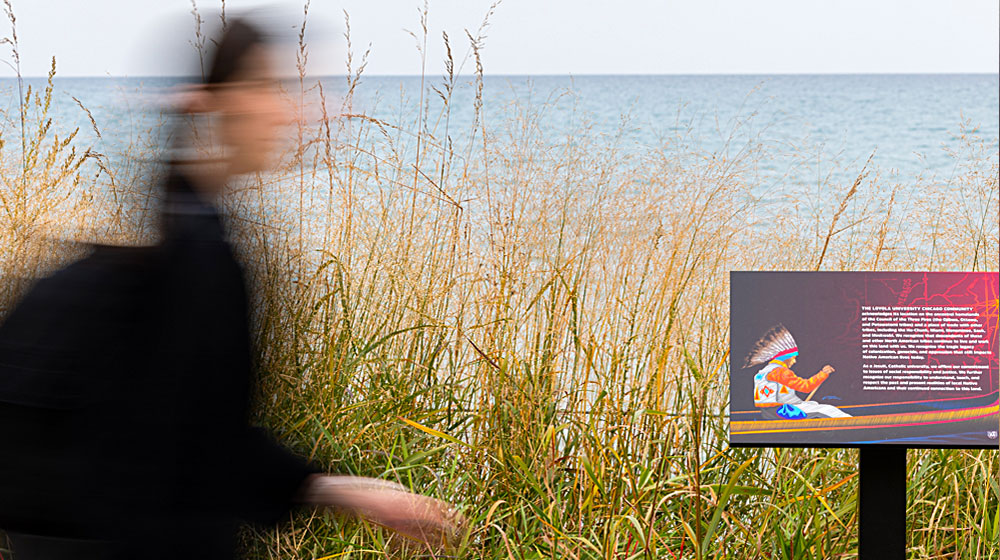

Land Acknowledgement Signage Unveiling
On October 11, 2023, Loyola University and its School of Environmental Sustainability hosted an event to honor Indigenous Peoples' Day and unveil new signage displaying the university's Land Acknowledgement. Nearly 90 people gathered to hear from a panel of local Indigenous leaders and view the signs. Read more.
Loyola University Chicago’s Land Acknowledgement
The culmination of a multi-year process, Loyola’s Land Acknowledgement started when a group of faculty, students, and staff convened to discuss what our university can do to welcome and support Indigenous people—a population that remains underrepresented in higher education. The group consulted with local Indigenous leaders, historians, students of Indigenous ancestry, and others. Together, they crafted the Land Acknowledgement statement, along with a set of recommendations on how our university can act in solidarity with Native peoples and advance our social justice mission. The university ratified the Land Acknowledgement in 2020, and we continue our efforts to build a supportive and welcoming environment for Indigenous people at Loyola. In 2023, the university installed campus signs displaying the Land Acknowledgement. The signs feature illustrations by Indigenous artist Buffalo Gouge.
Land Acknowledgement Statement
THE LOYOLA UNIVERSITY CHICAGO COMMUNITY ACKNOWLEDGES its location on the ancestral homelands of the Council of the Three Fires (the Ojibwa, Ottawa, and Potawatomi tribes) and a place of trade with other tribes, including the Ho-Chunk, Miami, Menominee, Sauk, and Meskwaki. We recognize that descendants of these and other North American tribes continue to live and work on this land with us. We recognize the tragic legacy of colonization, genocide, and oppression that still impacts Native American lives today.
As a Jesuit, Catholic university, we affirm our commitment to issues of social responsibility and justice. We further recognize our responsibility to understand, teach, and respect the past and present realities of local Native Americans and their continued connection to this land.
INDIGENOUS ARTIST BUFFALO GOUGE designed campus signage displaying Loyola’s Land Acknowledgement. He based the pieces on 19th-century photographs of Indigenous people, digitizing the images and transforming them into colorful illustrations. Gouge added objects and clothing ornamentation appropriate for the Potawatomi and other local tribes and set the figures over a historical map of the region. The background wash of maroon and gold creates a connection to Loyola. The images are overlain on a map of the original Indigenous peoples' occupancy of the land that is now called the Chicago region.
BUFFALO GOUGE WAS BORN IN OKLAHOMA CITY, OKLAHOMA and is of Creek and Cherokee descent. He currently resides in Tahlequah, Oklahoma. Buffalo is a contemporary Native American artist, and his style is best described as fast with bright colors. He enjoys painting all types of subjects, but portraits are his main focus.
Buffalo attended the Institute of American Indian Arts (I.A.I.A.) in Santa Fe, New Mexico. After receiving his associate’s degree in fine arts, he stayed in Santa Fe to pursue his childhood dream of becoming a full-time professional artist. He achieved this dream in 2004.
Creek/Seminole artist Jerome Tiger remains Buffalo’s biggest inspiration. The beauty and graceful style of Tiger’s paintings first captured Buffalo’s attention. Buffalo says, “My eighth-grade art teacher showed me a few Oklahoma Native American artists like Robert Redbird, Rance Hood, and Gary White Deer. When she showed me Jerome Tiger, I was blown away. I couldn’t believe how strong and graceful his paintings were. I studied and studied his paintings for the next few years.”
When asked about his current inspiration behind his art, Buffalo said, “My son is the reason I began to paint again. When I brought out my paints and brushes and started to paint, Elijah was right there watching me closely.”
Land Acknowledgement Signage Unveiling
On October 11, 2023, Loyola University and its School of Environmental Sustainability hosted an event to honor Indigenous Peoples' Day and unveil new signage displaying the university's Land Acknowledgement. Nearly 90 people gathered to hear from a panel of local Indigenous leaders and view the signs. Read more.
